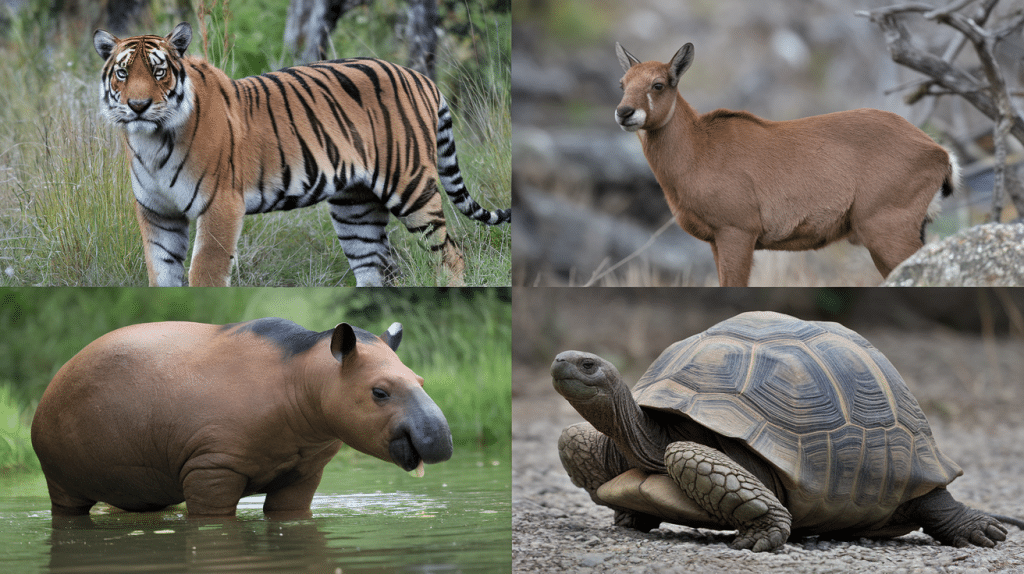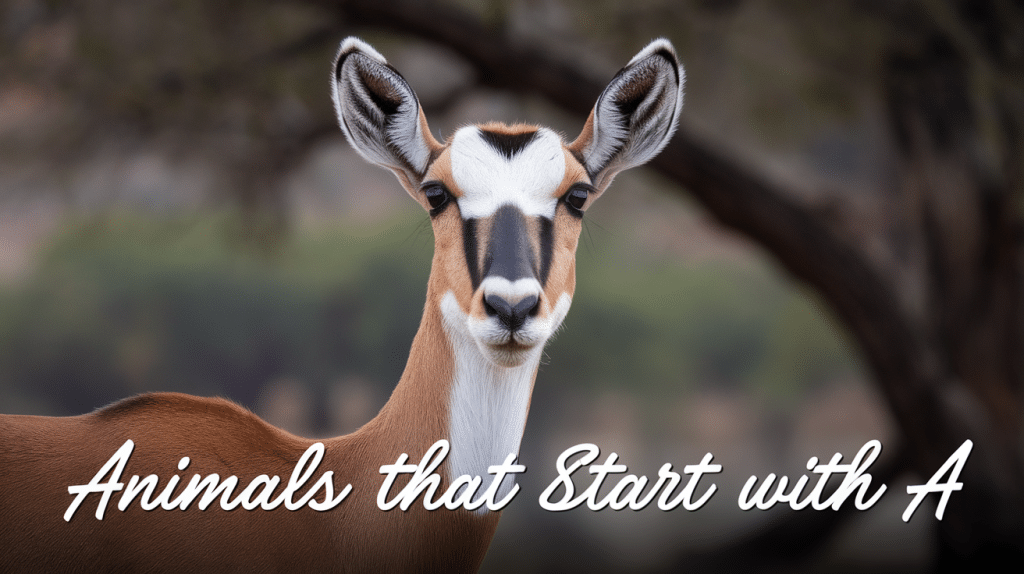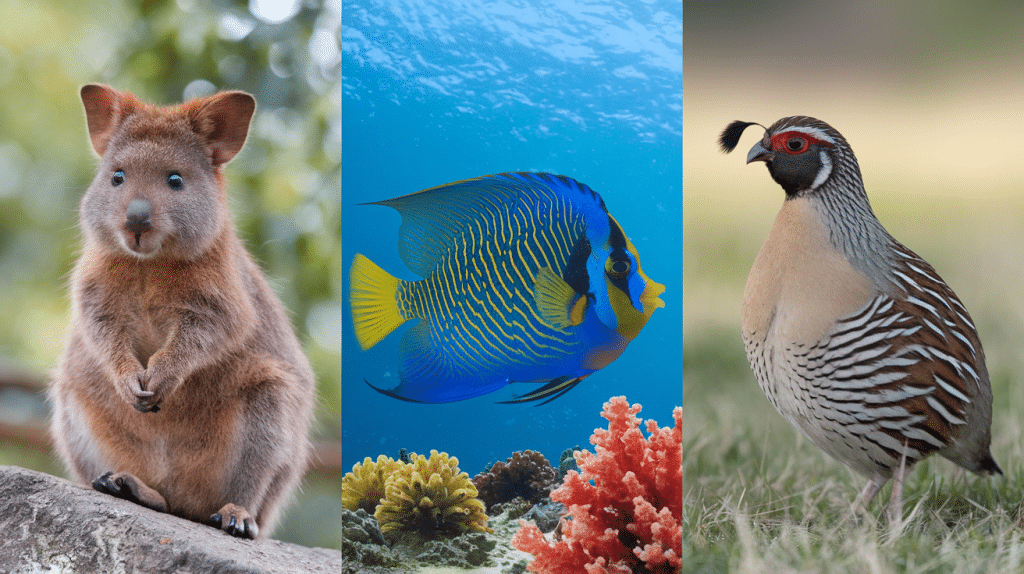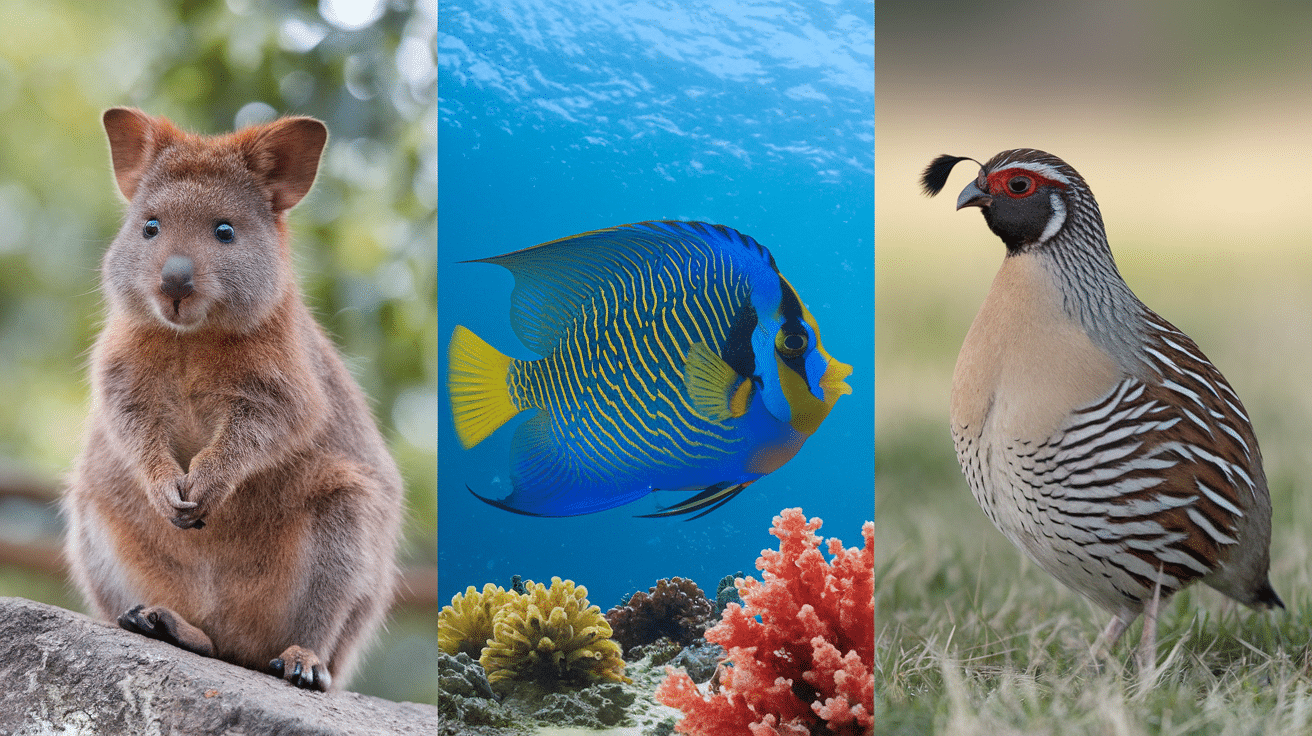Now Reading: 31 Animals that Start with K: List and Fun Facts
-
01
31 Animals that Start with K: List and Fun Facts
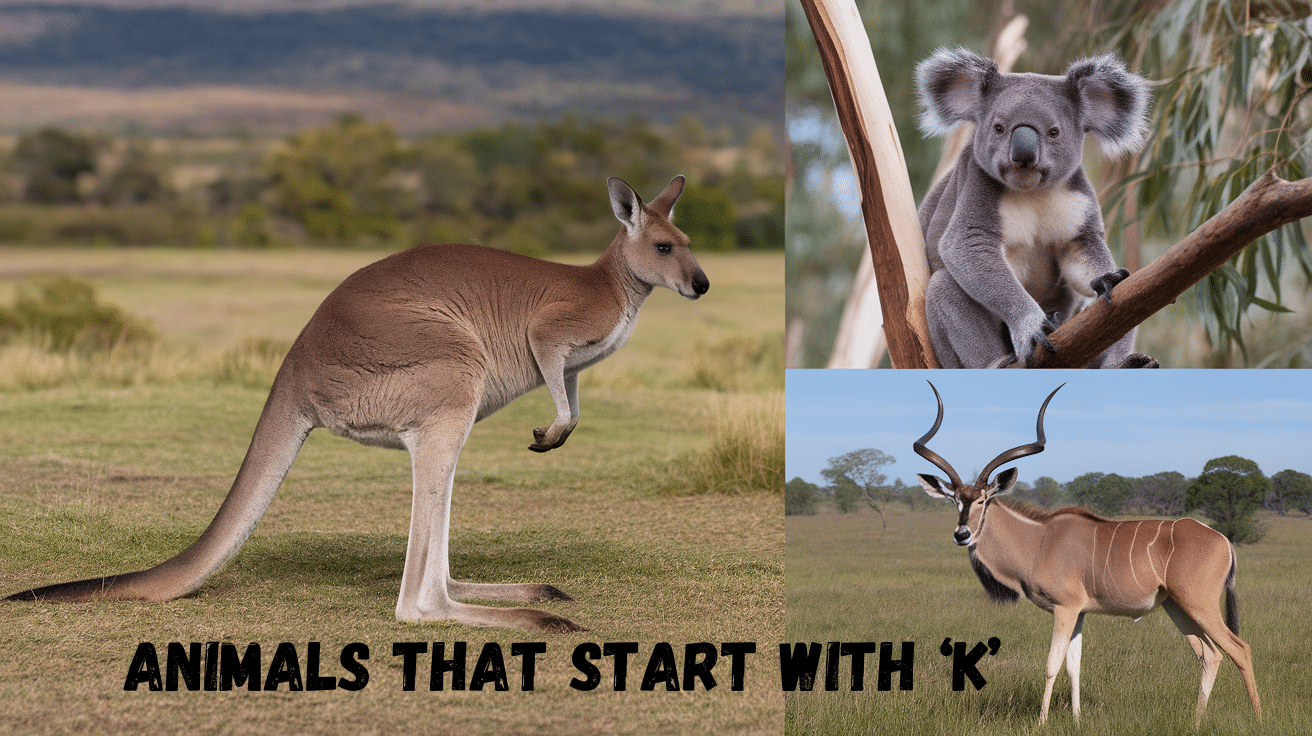
31 Animals that Start with K: List and Fun Facts
Have you ever wondered which fascinating creatures share their first letter with kangaroos?
The animal kingdom has some remarkable species whose names begin with K, from powerful predators to gentle giants.
Some of these animals live in remote corners of our planet, while others might be closer to home than you think.
In this article, we’ll introduce you to various interesting animals whose names start with K. You’ll learn about their unique features, natural habitats, and surprising behaviors.
Students working on projects, animal enthusiasts, and people curious about wildlife will all find something interesting about these remarkable creatures.
Let’s find these notable K-named animals together.
Popular Animals Starting with K
1. Kangaroo

These powerful marsupials can leap up to 25 feet in a single bound and use their muscular tails for balance.
They are distinguished by their strong hind legs, large feet, and long muscular tails, with most species having grey-brown fur.
- Scientific Name: Macropodidae (family)
- Origin: Australia
- Habitat: Grasslands, Plains, and Open Woodlands
- Fun Fact: Female kangaroos have a built-in natural suspension system in their legs that helps them conserve energy while hopping.
2. Koala

These specialized leaf-eaters spend most of their time sleeping up to 22 hours a day due to their low-energy diet.
They have thick grey fur, round fluffy ears, and strong limbs for climbing with sharp claws.
- Scientific Name: Phascolarctos Cinereus
- Origin: Australia
- Habitat: Eucalyptus forests of eastern and southern Australia
- Fun Fact: Koalas have fingerprints remarkably similar to human fingerprints.
3. Kinkajou

These agile nocturnal creatures have excellent night vision and can rotate their ankles 180 degrees while climbing.
They have soft golden-brown fur, large eyes, and a prehensile tail that acts like an extra hand.
- Scientific Name: Potos Flavus
- Origin: Central and South America
- Habitat: Tropical Rainforests
- Fun Fact: Their long, thin tongue can extend up to 5 inches to help them reach nectar in flowers.
4. Kudu

These majestic antelopes are known for their impressive spiral horns and excellent jumping ability.
They have distinctive white stripes on their body and large, round ears that help them detect predators.
- Scientific Name: Tragelaphus Strepsiceros
- Origin: Africa
- Habitat: Woodlands, Savannas, and Mountainous Regions
- Fun Fact: Male Kudus can leap over 8-foot fences from a standing position.
5. Kea

These intelligent alpine parrots are known as the world’s only mountain parrots and can solve complex puzzles.
They have olive-green plumage with bright orange feathers under their wings and a distinctive curved beak.
- Scientific Name: Nestor Notabilis
- Origin: New Zealand
- Habitat: Mountain Regions of New Zealand’s South Island
- Fun Fact: They’ve been observed using sticks as tools to set off stoat traps to get the bait inside.
6. King Cobra

This magnificent snake is the world’s longest venomous snake and can raise the front third of its body off the ground to look a person in the eye.
Its distinctive hood and intelligent, alert eyes make it one of the most recognizable and respected snakes in the world.
- Scientific Name: Ophiophagus Hannah
- Origin: South and Southeast Asia
- Habitat: Dense Highland Forests, Mangrove Swamps, and Rainforests
- Fun Fact: They are the only snakes in the world that build nests for their eggs.
7. Komodo Dragon

The largest living species of lizard, these powerful predators can detect carrion from several miles away.
They have muscular bodies covered in tough, durable scales, powerful limbs, and a long, yellow, deeply forked tongue.
- Scientific Name: Varanus Komodoensis
- Origin: Indonesian Islands
- Habitat: Tropical Savanna Forests and Woodland
- Fun Fact: Their saliva contains over 50 strains of bacteria that help kill prey that escape their initial attack.
8. Kiwi
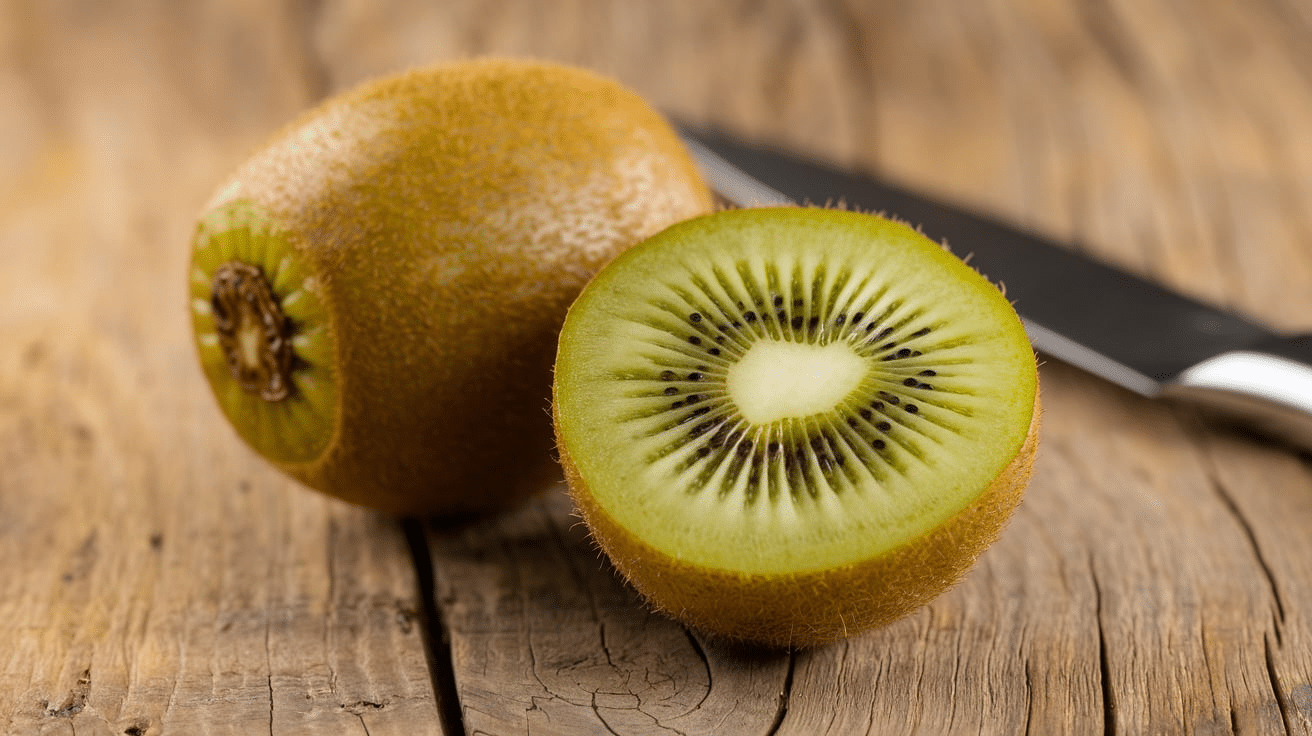
These flightless birds have tiny wings, whisker-like feathers, and long beaks with nostrils at the tip.
Despite being the size of a chicken, they lay eggs that are about 20% of their body weight.
- Scientific Name: Apteryx
- Origin: New Zealand
- Habitat: Native Forests and Grasslands
- Fun Fact: They are the only birds in the world with nostrils at the end of their beaks.
9. Kookaburra

Known as the laughing bird of Australia, these skilled hunters can catch snakes by dropping them repeatedly from great heights.
They have a stout body, large head with a long, powerful beak, and distinctive brown and white feather patterns.
- Scientific Name: Dacelo Novaeguineae
- Origin: Australia
- Habitat: Eucalyptus Forests, Woodlands, and Urban Areas
- Fun Fact: Their distinctive “laugh” is a territorial call that can be heard Up to a mile away.
10. Kakapo

The World’s only flightless and nocturnal parrot, these critically endangered birds have a distinctive owl-like face.
They have mottled yellow-green plumage that provides excellent camouflage and a distinctive disc of fine feathers around their faces.
- Scientific Name: Strigops Habroptilus
- Origin: New Zealand
- Habitat: Forest and Grassland Areas
- Fun Fact: They can live up to 90 years or more in the wild.
11. Kite

These graceful birds of prey are known for their exceptional ability to glide for hours without flapping their wings.
They have distinctive forked tails and slender wings that allow them to perform impressive aerial maneuvers while hunting.
- Scientific Name: Milvus (genus)
- Origin: Found Worldwide
- Habitat: Open Areas, Farmlands, and Urban Environments
- Fun Fact: They can eat their prey while flying, transferring food from their talons to their beaks mid-flight.
12. Knifefish

These unusual fish can generate and sense electric fields for navigation and communication.
They have long, knife-like bodies and can swim both forward and backward with equal ease using an undulating fin that runs along their underside.
- Scientific Name: Gymnotiformes (order)
- Origin: South and Central America
- Habitat: Rivers and Streams in Tropical Regions
- Fun Fact: They produce weak electric fields up to 500 times per second.
13. Kangaroo Rat

These remarkable rodents can leap up to 9 feet in a single bound and never need to drink water.
They have large back legs, tiny front legs, and long tails that help them balance while hopping.
- Scientific Name: Dipodomys
- Origin: North America
- Habitat: Desert and Arid Regions
- Fun Fact: They can survive without drinking water, getting all moisture from seeds they eat.
14. Kermode Bear (Spirit Bear)

These rare white bears are actually black bears with a recessive gene that makes their fur white.
They maintain the same body structure as black bears but have cream-colored fur that gives them a ghostly appearance.
- Scientific Name: Ursus Americanus Kermodei
- Origin: British Columbia, Canada
- Habitat: Temperate Rainforests
- Fun Fact: They are better at catching fish than their black-furred relatives because their white fur is less visible to fish.
15. Karakul Sheep

These hardy sheep are known for their distinctive curled wool and ability to survive in extreme conditions.
They have a robust build with unique, tightly curled fleece that changes texture as they age.
- Scientific Name: Ovis Aries
- Origin: Central Asia
- Habitat: Arid and Semi-Desert Regions
- Fun Fact: They are one of the oldest domestic sheep breeds, dating back to 1400 bc.
16. Kelp Gull

These adaptable seabirds are skilled aerial hunters with remarkable intelligence in tool use.
They have white plumage with black wings, yellow beaks with a red spot, and pink legs, making them easily recognizable along coastlines.
- Scientific Name: Larus Dominicanus
- Origin: Southern Hemisphere Coastlines
- Habitat: Coastal Areas, Islands, and Urban Waterfronts
- Fun Fact: They’ve been observed using bread as bait to catch fish.
17. Knobbed Hornbill

These large birds are distinguished by their enormous casque (horn-like structure) on their bills and their skillful fruit-catching abilities.
They have black plumage with a white tail, and males have a larger, more colorful casque than females.
- Scientific Name: Aceros Cassidix
- Origin: Indonesia
- Habitat: Tropical and Subtropical rainforests
- Fun Fact: The male seals the female into a tree cavity during nesting, leaving only a small slit to pass food through.
18. Kafue Lechwe

These Specialized aquatic antelopes can run through deep water with remarkable speed and agility.
They have reddish-brown coats, lyre-shaped horns, and specialized splayed hooves for moving through marsh environments.
- Scientific Name: Kobus Leche Kafuensis
- Origin: Zambia
- Habitat: Floodplains and Marshlands
- Fun Fact: Their hooves secrete an oily substance that helps protect them from prolonged water exposure.
19. Katydid

These Masters of camouflage can mimic leaf shapes and colors with incredible accuracy.
They have large, leaf-like wings and long antennae, with some species displaying stunning colors beneath their camouflaged exterior.
- Scientific Name: Tettigoniidae
- Origin: Found Worldwide
- Habitat: Forests, Grasslands, and Urban Gardens
- Fun Fact: Some species can produce sounds at frequencies high enough to repel bats.
20. Kashmir Stag (Hangul)

This majestic deer species is known for its impressive antlers and ability to navigate steep mountain terrain.
They have a reddish-brown coat that turns grayish in winter, with males sporting magnificent multi-pointed antlers.
- Scientific Name: Cervus hanglu hanglu
- Origin: Kashmir Valley, India
- Habitat: pine forests and alpine meadows
- Fun Fact: Males shed and regrow their antlers annually, with each new pair typically larger than the last.
21. Kentucky Cave Salamander

These rare amphibians have evolved to live their entire lives in complete darkness.
They have translucent skin, underdeveloped eyes, and external gills that remain throughout their adult life.
- Scientific Name: Eurycea Spelaea
- Origin: Kentucky, USA
- Habitat: Underground Streams and Caves
- Fun Fact: They can detect prey through subtle water movements using special sensory organs.
22. Knob-Tailed Gecko

These unusual geckos have a distinctive knob at the end of their tails used for fat storage.
They have large eyes, spiny scales, and the ability to change color slightly to match their surroundings.
- Scientific Name: Nephrurus (genus)
- Origin: Australia
- Habitat: Arid and Semi-Arid Regions
- Fun Fact: They use their tail knob to store fat, which helps them survive long periods without food.
23. Klamath Black Salamander

These secretive amphibians are excellent climbers despite their small size.
They have sleek black bodies with tiny white flecks and specialized toe pads for gripping wet surfaces.
- Scientific Name: Aneides Klamathensis
- Origin: Pacific Northwest, USA
- Habitat: Moist forest floors and rocky areas
- Fun fact: They can climb vertical surfaces and even walk upside down on rough surfaces.
24. Korean Hare

These nimble mountain dwellers have exceptional jumping abilities and can navigate steep terrain with ease.
They have distinctive brown-grey fur that changes color seasonally, and longer hind legs are adapted for mountain living.
- Scientific Name: lepus coreanus
- Origin: Korean Peninsula
- Habitat: Mountain Forests and Grasslands
- Fun Fact: They can leap up to 10 feet in a single bound while Running Uphill.
25. Kākā (new Zealand Parrot)

These intelligent parrots are skilled tool users and problem solvers.
They have olive-brown plumage with scarlet flashes under their wings and a distinctive brush-tipped tongue for extracting nectar.
- Scientific Name: Nestor Meridionalis
- Origin: New Zealand
- Habitat: lowland and mountain forests
- Fun Fact: They can use sticks to pry open tree bark and even solve mechanical puzzles.
26. King Vulture

These striking birds have vibrant orange and red head wattles that contrast with their white plumage.
Despite their imposing size and appearance, they are extremely efficient at soaring and can stay aloft for hours using thermal currents.
- Scientific Name: Sarcoramphus Papa
- Origin: Central and South America
- Habitat: Tropical Lowland forests and savannas
- Fun Fact: They have the strongest beak of all vultures, capable of tearing through tough hides that other vultures can’t pierce.
27. Kordofan Giraffe

One of the rarest giraffe subspecies, these elegant giants have distinctive geometric patterns.
They have a uniquely patterned coat with pale buff background and patches that are more angular than other giraffe subspecies.
- Scientific Name: Giraffa Camelopardalis Antiquorum
- Origin: Central Africa
- Habitat: Savannas, grasslands, and open woodlands
- Fun Fact: Each individual’s spot pattern is as unique as a human fingerprint.
28. Kunekune Pig

These friendly, small-sized pigs are known for their placid temperament and distinctive facial tassels.
They have short, upturned snouts, round bodies, and come in a variety of colors including black, brown, and ginger.
- Scientific Name: Sus Scrofa domesticus
- Origin: New Zealand
- habitat: Domesticated environments
- Fun Fact: They can be kept on grass alone, unlike most other pig breeds.
29. Karoo Thrush

These adaptable songbirds are skilled urban survivors with melodious calls.
They have olive-brown upperparts, speckled breasts, and distinctive yellow eye-rings.
- Scientific name: Turdus Smithi
- Origin: Southern Africa
- Habitat: Urban gardens, parks, and semi-arid regions
- Fun Fact: They have learned to use swimming pools as water sources in urban areas.
30. Kipunji Monkey

These rare primates were only discovered in 2003 and have a distinctive honk-bark call.
They have long, brown fur, a distinctive crest of hair on their heads, and white patches on their belly.
- Scientific Name: Rungwecebus Kipunji
- Origin: Tanzania
- Habitat: Mountain Forests
- Fun Fact: They are the first new genus of African monkey to be discovered in 83 years.
31. Kenyan Sand Boa

These small but muscular snakes are experts at swimming through loose sand.
They have smooth, cylindrical bodies with distinctive patterns and small eyes positioned on top of their heads.
- Scientific Name: Eryx Colubrinus
- Origin: Eastern Africa
- Habitat: Sandy and Semi-Arid Regions
- Fun Fact: They hunt by burying themselves in sand and ambushing prey that walks overhead.
32. Krill

These tiny Crustaceans Form massive swarms that can be seen from space.
They have transparent bodies with visible internal organs and bioluminescent organs that can produce light.
- Scientific Name: Euphausiidae (family)
- Origin: Found in All Oceans
- Habitat: Ocean waters, particularly polar regions
- Fun Fact: A Single swarm can contain up to 2 million tons of krill and stretch for kilometers.
33. Kuban Tur

These agile mountain goats are masters of navigating steep rocky slopes and can jump across wide chasms.
They have strong muscular bodies, curved horns, and thick winter coats that help them survive in harsh mountain environments.
- Scientific name: Capra Caucasica Caucasica
- Origin: Western Caucasus mountains
- Habitat: Alpine zones and rocky mountain slopes
- Fun Fact: Males can face off in spectacular horn-clashing battles that can be heard echoing through mountain valleys.
34. Kaluga Sturgeon

These massive freshwater fish are among the world’s largest freshwater fish species, capable of growing to enormous sizes.
They have a shark-like body with rows of bony plates and a distinctive pointed snout.
- Scientific Name: Huso Dauricus
- Origin: Amur River Basin
- Habitat: large rivers and estuaries
- Fun Fact: They can live up to 80 years and grow to over 18 feet in length.
35. Kerguelen Tern

These hardy seabirds are adapted to life in some of the world’s most remote and windswept islands.
They have pale grey plumage, black caps, and red-orange beaks that contrast beautifully with their coloring.
- Scientific Name: Sterna Virgate
- Origin: Southern Indian ocean
- Habitat: Sub-antarctic islands and coastal areas
- Fun Fact: They can hover perfectly still in strong winds while searching for prey in the water below.
36. Killer Whale

These highly intelligent marine mammals are actually the largest members of the dolphin family.
They have distinctive black-and-white coloring with a tall dorsal fin and are known for their complex social structures and hunting strategies.
- Scientific name: Orcinus orca
- Origin: All oceans worldwide
- Habitat: Marine environments from polar to tropical waters
- Fun fact: Each pod has its own dialect of distinct sounds that are passed down through generations.
Wrapping It Up
From the swift kestrel soaring through the skies to the tiny killifish swimming in coastal waters, k-named animals showcase the incredible diversity of life on Earth.
Each of these creatures plays a vital role in their ecosystem, whether they’re predators helping control prey populations or herbivores maintaining plant life.
By learning about these animals, we gain a deeper appreciation for the natural world around us.
While some of these species face challenges from habitat loss and climate change, understanding them better helps us protect their future.
Hopefully, this guide has helped you uncover some new favorite animals in the kingdom of k-named creatures.















